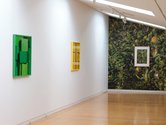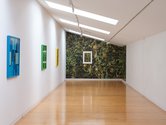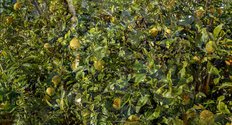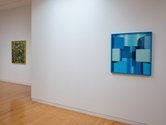John Hurrell – 14 June, 2021
This is an exciting show to explore, because you wonder about your own powers of perception and visual analysis when faced by a computer generated image that correlates in a subtly fragmented fashion with more than one ‘outside world'. The logic incorporated into the software manufactures photographs that taunt us for having blind faith in ‘the natural', for the resulting distortions are very discreet.
In this unusual exhibition, by presenting two types of project (A Ruse and ICONS) side by side, Shaun Waugh demonstrates his inventive use of Adobe Photoshop focus stacking software. This enables two photographs to be merged that initially featured two quite dissimilar focal points. In other words, through programmed digital modification a third fictitious (hybrid) image can be created.
Though they share common colours, and the same software, A Ruse and ICONS toy with separate subject matters, and different sets of visual and conceptual qualities. Ruse involves two photographs: one of a fruit-bearing lemon tree, and the other of a leafy kawakawa bush. One is indigenous and valued by Māori for its healing properties (amongst other things), the other is imported and like kawakawa is drunk as an infusion. The other suite of photographs, ICONS, features Waugh’s son’s coloured toy blocks. They have been photographed twice, with the stacked cubes turned to different angles in relation to the position of the camera.
In A Ruse (v), with the botanical image papered onto the narrow end wall that meets the sloping roof, it seems at first glance like an ordinary double exposure, but with sections of each ‘negative’ masked off. The two plants become optically entangled, with ghostly kawakawa stems casting pale linear patterns on darker expanses of glossy green, and certain rippled edges of insect-devoured kawakawa leaves repeated, the apertures peeking through to the lemon tree behind. Some of the more obvious lemon fruit have turned into flat globes, with their skin now becoming brittle and eggshell thin.
Superimposed on the wall is an enlarged portion of the same image, framed and under glass, and covering part of its own creation, hiding its own original (comparatively) reduced iconography.
The ICONS series is more subtle, with strange distortions occurring in the piled-up blocks. The wooden forms change shape, as do the negative spaces between them, and the shadows and shiny surface reflections. The brightly coloured module masses go through peculiar planar permutations, narrowing, extending or curving in unexpected places.
This is an exciting show to explore, because you wonder about your own powers of perception and visual analysis, especially when faced by a computer generated image that correlates in a subtly fragmented fashion with more than one ‘outside world’. The logic incorporated into the software manufactures photographs that taunt us for having blind faith in ‘the natural’, for the resulting distortions are very discreet. Understandably, when you go down the stairs and leave the gallery to saunter down Putiki Street, you are a little nervous. The body that you wear is not quite as close as it used to be.
John Hurrell












 Two Rooms presents a program of residencies and projects
Two Rooms presents a program of residencies and projects Advertising in this column
Advertising in this column



This Discussion has 0 comments.
Comment
Participate
Register to Participate.
Sign in
Sign in to an existing account.